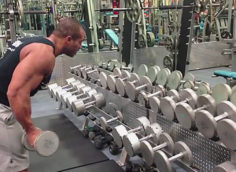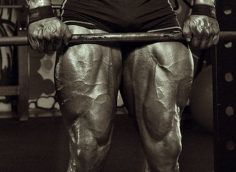Last year I unveiled Hammer Down Endurance (HDE) to the mixed martial arts world. The purpose of the workouts was simple: build endurance strength that's specific to a fighter's needs.
It's an outstanding system that works hella good. But ever since I released that article, I've been inundated with requests to design a plan that's easier to perform in a regular ol' gym.
Most of the drills in HDE revolve around medicine ball throws and total body cable movements. But some gyms don't allow you to throw objects, nor do they have any medicine balls. And some gyms don't have any good cable pulley systems either. As such, I got hundreds of requests for an alternate system.
So that was the mission that was handed to me from aspiring fighters: devise a set of workouts that'll build ass-kicking endurance without getting your ass kicked out of the gym.
Fret no more, my hardcore friends, because I've answered your call. Full Throttle is here!
The Necessity of Adherence
As a writer who designs programs for the masses, adherence is paramount. I could design an ideal set of workouts for a group of people, but if a large majority of the readers don't have access to the equipment I recommend, the program is a bust. In other words, a successful program is one that takes into consideration a person's available training time and equipment.
Those who personally train with me, and who are familiar with my articles, are often surprised by the difference between my magazine programs and my one-on-one training sessions. The reason is simple: I have access to numerous pieces of esoteric equipment that most people don't have.
With that in mind, I'm going to give you a bare-bones workout plan that will develop strength endurance with fighters in mind. A fighter must possess numerous fitness qualities, and he must train each of those qualities with movements that are as dynamic and explosive as possible. So that's why it's damn tough to devise workouts that are specific to fighters with nothing but barbells and dumbbells.
Considering all of the requests I've had for simpler methods to build strength endurance, and since most people have access to barbells and dumbbells, I decided to make it my mission to develop fight specific strength endurance with minimal equipment. (Think Sylvester Stallone in Rocky IV.) But don't confuse "simple" with "easy."
But this article ain't just for fighters – anyone can benefit from this information!
Why is Strength Endurance So Important?
Fighters must develop three fitness qualities to the highest possible level. The qualities are maximal (absolute) strength, endurance, and mobility. Of those three I really believe that endurance is probably the most important quality. Specifically, I think the actual training that fighters do to build strength endurance is probably most beneficial.
Why? The reason is mental toughness. There's no other form of training that tests a fighter's mental toughness better than high-intensity endurance training. The stress on the cardiovascular system, the nauseating levels of lactate, and the drain on cognition can't be underestimated.
That's important because the mental toughness that's enhanced with endurance training will also carry over into the fights. And, of course, it doesn't matter how great a fighter's absolute strength and mobility are, if he's depleted of energy after a few minutes, he'll end up in a potentially catastrophic position.
Those are the reasons why I feel endurance training is so important.
Attacking Old School Endurance Training
The first problem with most endurance systems designed for fighters is that the workouts revolve around too much running. You should know that running and fighting have very little carryover between them. Guys like Jason Feruggia, Alwyn Cosgrove, and Charles Poliquin have all done an excellent job of bringing to light the ineffectual relationship between running and fighting. And I'm here to put another nail in the coffin that's filled with low-intensity running.
But doesn't long-distance running build up a person's aerobic system, you ask? Sure, it never hurts to build up your aerobic capacity, but at what cost?
With long-distance running, the cost is very high. The cost is high because it can overload your adrenal glands. The last thing a fighter needs is more adrenal fatigue. Guys such as Chuck Liddell will train three times every day. A typical daily plan for elite fighters consists of energy systems work in the morning, strength training in the afternoon, and technique training at night. It's no wonder these guys must really taper off their training the week before the fight!
Not only is the cost of running high, but the benefits are about as low as a hooker's morals. The benefits of long distance running are low because it doesn't train your body with enough intensity to carry over into fighting. After all, there are very few sports that are as intense and demanding as a few rounds of fighting.
Fighters need a ton of explosive strength endurance. Running doesn't build that quality; it'll drain your explosiveness and make you as weak as Paris Hilton after an all night bender. Furthermore, fighting is a total body sport; running isn't.
Don't get me wrong, running has its place. I use a two-mile run to get a basic assessment of a fighter's aerobic capacity when he trains with me for the first time. But beyond that, all forms of running in my workouts metamorphose into loaded sprinting.
So instead of having a fighter run for 15 minutes, I'll have him bear hug a sandbag that's approximately 100 pounds and sprint with it for 40 yards. Then he'll rest for 45-60 seconds before repeating the loaded sprint/rest task 6-10 more times. Regardless of whether you're actually a fighter, that's an excellent way to spend 15 minutes of your time.
But therein lies the problem: many people don't have access to heavy sandbags or a place to sprint.
Another example is the sled. It doesn't matter how revered the sled is for building total body strength and endurance, most people simply don't have one available. And even if you did have one, you'd still need to find a hard, flat surface and you'd need to have plenty of heavy plates on hand.
Don't get me wrong, I think the sled is one of the most beneficial tools out there. If you can find a place to use one, jump over to Elite Fitness Systems and buy one. However, I also understand that a sled isn't practical for those with limited places to train. And do I even need to mention the impracticalities of a 600-pound tire? I didn't think so.
Now that you know the reasons why I decided to write another strength endurance plan for fighters, it's time to get to the good stuff!
The Full Throttle Exercises
Loaded Walk
Description: Grab one or two 45 pound plates or a 100 pound plate and hold it against your chest with your arms crossed. Walk forward for 10 steps as fast as possible, and then walk backward as fast as possible for 10 steps. Don't take long strides; keep your steps short in distance and brief in duration.
Clap Push-ups
Description: Assume a traditional push-up position on the ground with your hands shoulder-width apart. Push up as explosively as possible. When you elevate off the floor, clap your hands together and reset them on the ground before your body begins to drop down.
Elevated Wide-out Drops
Description: Stand on top of a 10-12" box or step with your feet close together. Jump and push your feet out to the side so you land with your feet wide. Drop down into a squat before jumping up on the box to the starting position. Don't rest your hips during the bottom position.
Quadruped Run
Description: From a standing position, place your hands on the floor in front of you as depicted below. From this position, "run" on all four limbs by extending your right leg as you stretch your right arm out. Then stretch your left arm out as you pull your left knee up. Continue with this quadruped run for 20 feet forward.
Plate Abduction
Description: Lay a 25, 35, or 45 pound plate flat on the ground. Stand next to the plate so the outside of your right foot is pressed against the edge of the plate. Crouch down into the "ready" position like a basketball player on defense. Maintain this position and extend your right leg out as far as possible, thus pushing the plate away from you. Continue for 10 plate slides before doing the same on your left.
One-Arm Dumbbell Row with Twist
Description: Assume a traditional one-arm dumbbell row position with your bent left leg and left hand resting on a bench. When you lower the dumbbell, let your torso twist forward when your arm is fully extended. As you pull the dumbbell up, twist your torso back. Perform five reps on each side without resting between arms.
180 Lunge
Description: From a standing position with your hands held high, do a reverse lunge. Then do a reverse lunge with your back leg angled out. Then do a side lunge. Then do a forward lunge out to the side. Finally, do a forward lunge. Repeat with the opposite leg.
Run Sprawl
Description: This drill starts by running in place for 10 seconds as fast as possible. Then, quickly drop down into the sprawl position. Immediately after you drop into the sprawl, pull your left knee up to your chest and stand up from that position.
Repeat the 10 second run in place, followed by the sprawl. After you drop down into the sprawl a second time, pull your right knee up to your chest and stand up. This sequence constitutes one rep. Perform this entire sequence 10 times (do 5 reps while standing with your right leg forward; do 5 reps while standing with your left leg forward).
Now that you know the exercises that make up the Full Throttle workouts, it's time for me to show you how to devise a plan of attack!
Which Plan You Should Follow
As I mentioned earlier, I do like the two-mile run for the purpose of assessing someone's aerobic capacity. And it can be beneficial for many fighters, but I've already touched on that issue in HDE.
Before you incorporate the Full Throttle workouts into your weekly plan, I want you to run for two miles as fast as you can. Your two-mile run time will determine whether you're beginner, intermediate, or advanced. Here's how it breaks down:
Two-Mile Run Time
Beginner: More than 15 minutes
Intermediate: 12-15 minutes
Advanced: Less than 12 minutes
Before we get to the workouts, it's important to note that it's very difficult, if not impossible, for me to accurately prescribe what load you'll need. As such, you'll see the acronym AHAP that denotes "as heavy as possible." You must be able to do these exercises at a very fast pace. So if you find yourself moving slowly, the load is too heavy. Err on the lighter side with all loaded exercises.
Also, you'll see the acronym AMAP that denotes "as many reps as possible." Again, speed is paramount, so if your speed of execution for, say, clap push-ups is greatly reduced, you did too many reps.
Full Throttle for Beginner
- Frequency: 3x/week (separated by at least 48 hours of rest)
- Loaded walk for 10 steps forward and backward with a load AHAP
- Rest 30 sesconds (30 seconds)
- Clap push-ups for AMAP
- Rest 15 sesconds
- Elevated wide-out drops for AMAP
- Rest 30 sesconds
- Quadruped run for 20 feet forward
- Rest 30 sesconds
- Plate abduction for 10 reps on each side with a load AHAP
- Rest 30 sesconds
- One-arm DB row on each side for 5 reps with a load AHAP
- Rest 15 sesconds
- 180 lunge on each side
- Rest 30 sesconds
- Run sprawl for 10 cycles (5 with each standing leg forward)
- Rest 1 minute and repeat once more
Full Throttle for Intermediate
- Frequency: 3x/week (separated by at least 48 hours of rest)
- Loaded walk for 10 steps forward and backward with a load AHAP
- Rest 25 sesconds
- Clap push-ups for AMAP
- Rest 10 sesconds
- Elevated wide-out drops for AMAP
- Rest 25 sesconds
- Quadruped run for 20 feet forward
- Rest 25 sesconds
- Plate abduction for 10 reps on each side with a load AHAP
- Rest 25 sesconds
- One-arm DB row on each side for 5 reps with a load AHAP
- Rest 10 sesconds
- 180 lunge on each side
- Rest 25 sesconds
- Run sprawl for 10 cycles (5 with each standing leg forward)
- Rest 1 minute and repeat twice more
Full Throttle for Advanced
- Frequency: 3x/week (separated by at least 48 hours of rest)
- Loaded walk for 10 steps forward and backward with a load AHAP
- Rest 20 sesconds
- Clap push-ups for AMAP
- Rest 5 sesconds
- Elevated wide-out drops for AMAP
- Rest 20 sesconds
- Quadruped run for 20 feet forward
- Rest 20 sesconds
- Plate abduction for 10 reps on each side with a load AHAP
- Rest 20 sesconds
- One-arm DB row on each side for 5 reps with a load AHAP
- Rest 5 sesconds
- 180 lunge on each side
- Rest 20 sesconds
- Run sprawl for 10 cycles (5 with each standing leg forward)
- Rest 45 sesconds and repeat twice more
Key Points
- It'll probably take a workout or two to dial in the correct loads. As mentioned, you should choose a load that doesn't slow you down. Keep the load light and the speed of execution fast.
- If you're a beginner or intermediate, you'll need at least a month of training on your designated level before progressing to the next level.
- You can perform the Full Throttle workouts on the same day as your fight training, but separate the two by at least 6 hours.
- You can perform these workouts on the same day as your maximal strength training, but do your maximal strength training earlier in the day and wait at least 6 hours before performing the Full Throttle workouts.
- I recommend that you ingest one-half serving of Plazma™ 5-15 minutes before these workouts, and one-half serving immediately after your workouts.
Closing
This is one ass-kicking plan that will build total-body strength endurance. If you don't have the luxury of performing HDE, or if you simply want a change of pace to boost fat loss and general physical preparedness (GPP), these workouts are for you!











